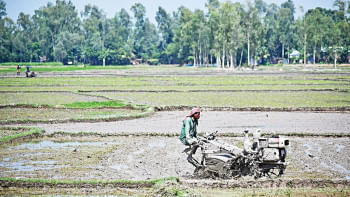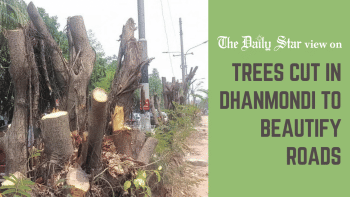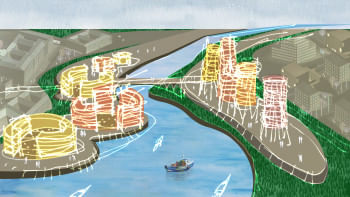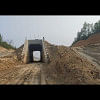How ‘sponge cities’ can solve Bangladesh’s flooding problem

Bangladesh experiences some of the wettest monsoons in the world due to it being located in a tropical territory. However, the average monthly rainfall decreased by 60 millimetres between June and August, despite the period being the peak monsoon season, according to the World Bank data. On the other hand, the increase in the mean monthly rainfall from September to October by 43 millimetres shows that the monsoon season is steadily lengthening and currently runs from March to October. Rising temperatures during winter and changing rainfall patterns have affected Bangladesh's distinct seasonality. As such, at a time of the year when a clear, blue sky is supposed to be covered in white clouds, it may start pouring instead.
The impacts of such weather events manifest differently in urban and rural areas. The urban setting in Bangladesh is unique because of the interconnectedness of different systems such as water supply, drainage, waste management, transport and communication, power supply, and so on. City life often comes to a halt if there is constant rain, which brings with it waterlogging, major traffic congestion, infrastructural damage, and health issues for citizens. A recent study, which analysed traffic in over 1,200 cities in 152 countries, found that Dhaka, the bustling capital of the country, ranked first on the list of the slowest-moving cities in the world. Mymensingh and Chattogram ranked ninth and 12th, respectively, among the 20 slowest cities.
Rapid spikes in population, unplanned urbanisation, climate extremes, uncontrolled land-filling to develop new residential areas, haphazard disposal of waste into the existing drainage system, and encroachment of lakes, canals, and rivers have all played a role in making these issues more pronounced in recent years. Meanwhile, coastal cities like Khulna, Jashore and Satkhira face intense waterlogging every monsoon.
Against this backdrop, the "sponge city" concept can be a possible solution for these at-risk cities. A sponge city is one that is built to passively absorb, clean, and use rainfall in an environmentally benign manner, reducing polluting and hazardous run-off. The approach comprises permeable roadways, rooftop gardens, rainwater harvesting, rain gardens, green spaces, and blue spaces such as ponds and lakes. If sponge city is properly implemented, it will be able to minimise the frequency and severity of floods, improve water quality, and allow cities to use less water per person.
The Chinese government introduced the concept of a sponge city in 2014, which was utilised to address urban surface-water floods and other water-related challenges, such as purification of urban run-off, peak run-off attenuation, and water conservation. The issue was brought into focus when flooding engulfed Beijing in 2012, crippling the city and killing dozens. Bangladesh can also adopt the sponge city concept to prevent flooding in its major and coastal cities. The country's megacities do not have ample space to drain water. The sponge city system allows water to seep into the soil where it falls, rather than directing it away as quickly as possible and storing it in extensive dams. Besides, the country has a history of loss of lives and housing due to failed flood protection dams. Barring natural streams to flow and then channelling the water through strong pipes through a concrete wall is not an adaptive solution—rather, it is against nature.
Furthermore, this concept can significantly contribute to mitigating the negative effects of climate change. When compared with grey infrastructure, a sponge city requires substantially less energy to maintain. June was the hottest month on record this year, which was certainly caused by extreme weather events. With the successful mitigation of urban flooding, an unintended benefit of sponge city is natural cooling that may prevent heatwaves. Besides, large green spaces in sponge cities absorb carbon dioxide, which may contribute to a lower amount of the greenhouse gas in the atmosphere.
This initiative could be life-saving in coastal cities, by ensuring a reliable natural source of drinking water. As a consequence of climate change, sea level rise has afflicted thousands of people and jeopardised the availability of drinking water. Excessive salinity, arsenic contamination, and dissolved iron in the water are contributing to this scarcity. Furthermore, these cities rely a great deal on groundwater extraction, with more than 82 percent of the supplied water coming from this source. Such widespread reliance accelerates the decline of the groundwater table. Amid this situation, natural streams and porous soils used in sponge city designs are beneficial for water filtration and reducing pollution, leading to less reliance on groundwater.
Aside from all these benefits, sponge cities will also promote biodiversity and aesthetic appeal, offering city people the opportunity to stay healthy and at peace. They will also directly contribute to SDG 11: Sustainable Cities and Communities, SDG 13: Climate Action, SDG 14: Life below Water, and SDG 15: Life on Land. All in all, if such an initiative is undertaken, the benefits will bring about a welcome change.
Monira Sharmin is a research student under the Postgraduate Programme in Disaster Management (PPDM) at Brac University. She can be reached at [email protected].
Views expressed in this article are the author's own.
Follow The Daily Star Opinion on Facebook for the latest opinions, commentaries and analyses by experts and professionals. To contribute your article or letter to The Daily Star Opinion, see our guidelines for submission.

 For all latest news, follow The Daily Star's Google News channel.
For all latest news, follow The Daily Star's Google News channel. 











Comments